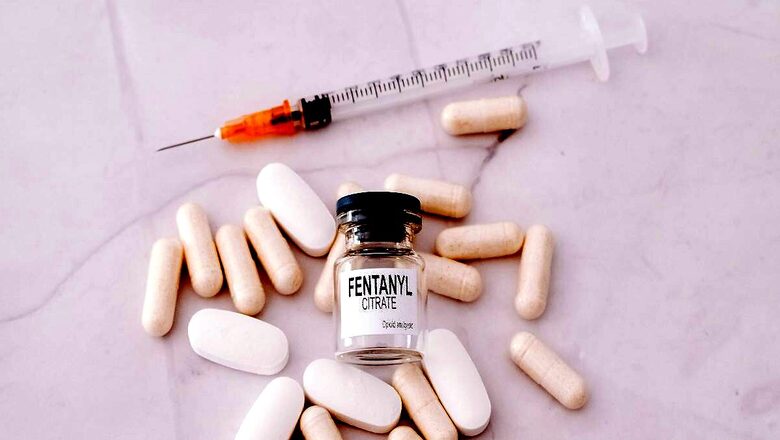
views
In April 2023, China’s Foreign Ministry Spokesperson Mao Ning dropped a bombshell by stating that the ongoing fentanyl drug crisis was “completely made in the USA.” U.S. Drug Enforcement Administration (DEA) Chief Anne Milgram termed fentanyl the “single deadliest drug threat our nation has ever encountered.”
In the United States, fentanyl is the leading cause of death among people aged between 18 and 49 years. In 2021, more than 100,000 Americans died due to drug overdoses; 70 percent of those were from synthetic opioids like fentanyl. President Joe Biden’s Administration has allocated over $24 billion in the year 2022 to strengthen public health interventions and expand access to treatment, prevention, and recovery tools, including Naloxone and fentanyl testing strips, which helps reduce overdose deaths.
To tackle this grave situation, there are 33 High Intensity Drug Trafficking Areas (HIDTAs), covering all 50 states in the US, to interdict narcotics trafficking. Consequently, seizures of illicit fentanyl, methamphetamine, and cocaine are all up significantly. In fiscal year 2022, Customs Border Patrol (CBP) seized nearly 15,000 pounds of fentanyl, nearly 2,000 pounds of heroin, 175,000 pounds of methamphetamine, and more than 70,000 pounds of cocaine. That’s twice as much as CBP seized in 2021 and four times as much as 2019. These numbers not only speak to the magnitude of the threat, but also the incredible effort and funds being mobilized to thwart drug trafficking.
Fentanyl is a synthetic drug used as a painkiller in the medical world. It is considered 100 times more powerful than opium-based drugs. It is also highly popular among drug addicts and drug traffickers in China, Mexico, Canada and the US. According to US Police sources, fentanyl is sold for $1.6 million per kg. It is popularly known by various names such as apache, tango cash, china girl, Chinatown, friend fever, great beer and murder. A kilogram of fentanyl is procured for $6000 but sold in the US for $1.6 million. 1 kilogram of fentanyl can be made into one million pills and can fetch up to $10 to 20 million on US streets.
President Biden’s inaugural National Drug Control Strategy, released in 2022, sets out a whole-of-government approach to attack the two drivers of the opioid overdose epidemic: untreated addiction, and the drug trafficking profits that fuel this crisis. The Administration’s approach addresses both public health aspects of this crisis as well as its national security, public safety, and economic dimensions. The executive order that the president issued in December 2021, “Imposing Sanctions on Foreign Persons Involved in the Global Illicit Drug Trade,” broadened and empowered the enforcement agencies to impose sanctions on a range of targets related to the trafficking of illicit synthetic opioids, giving the United States the ability to effectively target actors across the diffuse and decentralised global illicit drug supply chain. The national policy levers to disrupt the global illicit synthetic drug production and trafficking enterprise. This includes strategically targeting criminal facilitators and enablers, and the targeting of key vulnerabilities in the illicit fentanyl supply chain.
The United States is the only major country that has controlled the entire class of fentanyl drugs, presently on a temporary basis, a decision that the US Congress has yet to make permanent.
Though Chinese President Xi Jinping announced at the December 2018 G20 summit that China would place the entire class of synthetic opioids on a regulatory schedule, its operational law enforcement cooperation is not broad-based and only complements its geopolitical ambitions.
On Friday, March 31 2023, Vanda Felbab-Brown, Senior Fellow, Brookings Institution, submitted the following testimony to the US House of Representatives Subcommittee on National Security, Illicit Finance, and International Financial Institutions. The “Follow the Money: The CCP’s Business Model Fueling the Fentanyl Crisis” has shed light on the Chinese role: “Three US presidential administrations — those of Barack Obama, Donald Trump, and Joe Biden — have devoted diplomatic focus to induce and impel China to tighten its regulations vis-à-vis fentanyl-class drugs and their precursor chemicals and to more diligently enforce these regulations. China, however, sees its counternarcotics enforcement, and more broadly its international law enforcement cooperation, as strategic tools that it can instrumentalise to achieve other objectives. Unlike the US Government, which seeks to delink counternarcotics cooperation with China from the overall bilateral geostrategic relationship, China subordinates its counternarcotics cooperation to its geostrategic relations. As the relationship between the two countries deteriorated, China’s willingness to cooperate with the United States declined. Since 2020, China’s cooperation with US counternarcotics efforts, never high, declined substantially. In August 2022, China officially announced that it suspended all counternarcotics and law enforcement cooperation with the United States.
While China takes counternarcotics diplomacy in Southeast Asia and the Pacific very seriously, its operational law enforcement cooperation tends to be highly selective, self-serving, limited, and subordinate to its geopolitical interests. Beijing rarely acts against the top echelons of Chinese criminal syndicates unless they specifically contradict a narrow set of interests of the Chinese Government. Chinese criminal networks provide a variety of services to Chinese legal business enterprises, including those connected to government officials and the Chinese Communist Party (CCP).
China’s enforcement of precursor and fentanyl analog controls is also complicated by the challenge of systemic corruption in China and the incentive structures within which Chinese officials operate. Chinese Government officials also unofficially extend the umbrella of party protection and government authority to actors who operate in both legal and illegal enterprises as well as to outright criminal groups.
There is little visibility into China’s enforcement of its fentanyl regulations. But in the case of fentanyl and its precursor chemicals, small and middle-level actors in the chemical and pharmaceutical industries also appear to be the key perpetrators of regulatory violations and source for Mexican criminal groups. In the case of fentanyl and its precursors, Chinese triads – mafia-like organized crime groups — do not dominate drug production and trafficking.”
The US-China Bilateral Drug Intelligence Working Group and the Counter Narcotics Working Group provide a platform to exchange information on drug trends, discuss regulations, and improve cooperation on investigations. However, there is no formal treaty that is legally binding for both sides. Hence, there is limited visibility into China’s internal law enforcement actions. This lack of transparency became tighter in January 2020, when China became the focus of a negative international glare, due to suspicion that experiments conducted at a Wuhan laboratory led to the outbreak of the Covid pandemic. As a result, China clamped down on sharing information about how many inspections of pharmaceutical companies it undertook, how many anti-fentanyl and anti-precursor raids it conducted within China, and how many Chinese nationals were apprehended or indicted on fentanyl or precursor trafficking charges.
After the visit of the then House Speaker Nancy Pelosi to Taiwan in August 2022, China officially announced that it suspended all of its counternarcotics and law enforcement cooperation with the United States.
The role of Mexico is integral to any discussion about drug trafficking in the US. China’s intransigence has been further complicated by the Mexican government which is reluctant to share samples and information about its claimed lab busts and fentanyl and fentanyl precursor seizures. It does not permit the involvement of DEA agents, even as observers, in the interdiction operations it claims it has conducted. Extraditions of indicted drug traffickers to the United States from Mexico also remain tardy. Thus, for the present, Mexico’s law enforcement cooperation with the United States remains highly unsatisfactory.
Meanwhile, on April 6, 2023, Fox News reported that China dismissed the idea of being the source of fentanyl that is being trafficked across the US-Mexico border. Beijing’s Foreign Ministry Spokesperson Mao Ning stated, “There is no such thing as illegal trafficking of fentanyl between China and Mexico. We two countries have a smooth channel of counternarcotics cooperation and the competent authorities of the two countries maintain sound communication.”
The only silver lining happens to be the close cooperation between USA and India. The United States and India have formally established a Bilateral Counter Narcotics Working Group, to collaborate closely on youth substance use prevention, public health responses to substance use, the science of addiction medicine, law enforcement, and regulatory development and enforcement.
In September 2018, the Directorate of Revenue Intelligence arrested three people, including a Mexican national, for allegedly possessing over 10 kg of fentanyl hydrochloride, a narcotic substance worth over Rs 100 crore in the international market. A kilogram of fentanyl hydrochloride is equivalent to 10 kg of heroin. The seizure was made in a joint operation by DRI and scientists from Defence Research & Development Establishment (DRDO). Dr Mohammed Sadiq, a local businessman and a PhD scholar chemist, having a deep hatred for America, was running an illicit lab along with two other associates, namely George Solis, a Mexican national, and Manu Gupta. Fentanyl is so dangerous that a mere two milligrams of it are sufficient to kill a person. The 10 kg of seized fentanyl could have killed between 4 to 5 million people in the US, had it not been intercepted. Because of its mass killing potential, it is also called “Doomsday Chemical.”
In 2015, the Indian government had designated fentanyl and five other drugs as Essential Narcotic Drugs (END). In 2018, the government further added two direct fentanyl precursors, N-Phenethyl-4-piperidone (NPP) and (4-ANPP), 4-aminophenyl-1-phenethylpiperidine, or despropionyl fentanyl, (ANPP), as Schedule B, which restricted their export. In 2020, after domestically manufactured ANPP was trafficked in Mexico, the Indian government tightened controls over ANPP and NPP by designating them as Schedule A in the NDPS Order of 2013. This order brought the domestic manufacture, distribution, sale, possession, and use of those substances under national control.
In 2020, India and the United States established a Bilateral Counternarcotics Working Group to expand cooperation, combating the trafficking of precursors and illicit drugs. This working group is particularly focused on synthetic opioids such as fentanyl, tramadol, and tapentadol.
Dr Rahul Gupta, Director of the Office of National Drug Control Policy, USA, acknowledged India’s position as a pioneer in combating the fentanyl crisis and said that the two nations are collaborating on various associated problems, including addiction, treatment options, and the overlap between mental health and addiction. The US Customs and Border Protection has acknowledged India’s rise in the global fentanyl network, and India’s efforts to control illicit trafficking in Fentanyl.
In 2020, globally, 144 fentanyl-related substances were found with no legitimate uses. 122 of these substances were not under international control and 43 were possible fentanyl precursors. Given that existing domestic and international law insufficiently regulates fentanyl and its related substances, a more coherent global fentanyl governance framework needs to be established.
The author is IRS (Rtd), Ph.D. (Narcotics), Former Director General, National Academy of Customs, Indirect Taxes & Narcotics (NACIN). Views expressed are personal.
Read all the Latest Opinions here




















Comments
0 comment